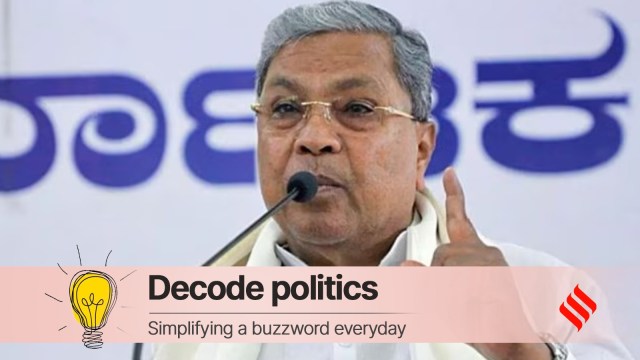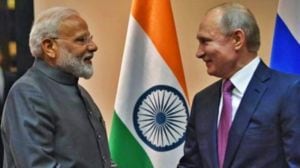Decode Politics: Karnataka caste survey findings, recommendations, and how it’s likely to play out
The report tabled before the Siddaramaiah Cabinet on April 11 has recommended several changes to the reservation matrix in Karnataka, a politically tricky matter.
 The final acceptance of the report and the recommendations is expected to be a win for Siddaramaiah's legacy as an OBC and mass leader. (Express File Photo)
The final acceptance of the report and the recommendations is expected to be a win for Siddaramaiah's legacy as an OBC and mass leader. (Express File Photo)The Karnataka caste survey report that was placed before the state Cabinet on April 11, over 13 months after the Karnataka State Backward Classes Commission (KSBCC) presented it to the Siddaramaiah government, has estimated the population of Other Backward Classes (OBCs) to be 69.6%, 38% more than existing estimates.
The Socio-Economic and Education Survey, as the survey is known, recommended increasing the OBC quota in the state from the existing 32% to 51%.
The report, yet to be made public, has recommended the creation of a new sub-category among the most backward classes to accommodate some communities that are currently categorised among OBCs and Dalits and have converted to Christianity.
The report was commissioned during Chief Minister Siddaramaiah’s first term in 2014 under a panel headed by then KSBCC chairman H Kantharaj. The report was submitted on February 29 last year but was not made public due to apprehensions within the Congress about possible adverse reactions from dominant communities such as the Vokkaligas and Lingayats, who labeled the exercise “unscientific and outdated”. Even Deputy CM D K Shivakumar, a Vokkaliga, opposed the release of the survey.
However, with the Congress central leadership emphasising its commitment to social justice at the All India Congress Committee (AICC) session in Ahmedabad last week — an April 9 resolution highlighted a caste survey conducted in Congress-ruled Telangana and called for a national census — the report was tabled before the Cabinet on April 11.
 Karnataka reservations at present. (Illustration by Abhishek Mitra)
Karnataka reservations at present. (Illustration by Abhishek Mitra)
What are the other key findings of the survey?
Among the other key findings is that the numbers of all communities among the main backward castes are higher than the estimated numbers for reservation.
* Vokkaligas and Lingayats
The numbers for Vokkaligas and Lingayats, the two dominant communities that fall under the III A and III B categories of OBC reservation, were found to be 12.2% and 13.6%, respectively.
The general population estimate for these dominant communities, which also get quotas in state jobs and education, has been 17% and 15% of the population, respectively, while their OBC reservations are currently 4% and 5%, respectively. The two communities have been demanding increased quotas in recent times.
Vokkaligas are politically identified with the Janata Dal (Secular) of former Prime Minister H D Deve Gowda, while Lingayats are generally identified as a support base of the former CM and BJP leader B S Yediyurappa.
* Muslims and other OBCs
The number of Muslims who fall under the II B category of Backward Classes in Karnataka was pegged at 12.58%, the single largest bloc after Dalits (who have 102 sub-castes) and Lingayats. The numbers for OBCs currently placed in the II A category were found to be 25.36%. The Most Backward Classes (I A category) stand at 5.84%.
Muslims currently get a 4% quota under the II B category, while their population is estimated to be around 12%. The OBCs get 15% under the II A category, while the Most Backward Classes get 4% under quota under the I A category, as against a 33% population estimated for the two combined groups.
OBCs and Muslims are considered a key and traditional vote base of the Congress along with the Scheduled Castes (SCs) and Scheduled Tribes (STs).
* SCs, STs, and the general category
The report pegs SCs in Karnataka at 18.27% (current estimate of 18%) and STs at 7.15% (previously estimated to be 6%) of the population, while the general category is pegged at 4.97%.
 Recommended reservations after caste survey. (Illustration by Abhishek Mitra)
Recommended reservations after caste survey. (Illustration by Abhishek Mitra)
What changes does the report suggest?
The report recommends changes to bring the quota matrix in line with the population of communities.
The commission has recommended a 19 percentage point (pp) increase in OBC reservation from 32% to 51% after deletion of 19% (of the total of 69.6%) under the creamy layer category.
The biggest increase in quota of 7 pp – from 15% to 22% – has been recommended for the II A category, which includes communities such as Kurubas to which CM Siddaramaiah belongs.
The commission has recommended the creation of a new Most Backward Classes category, called I B, to be carved out from the II A category that currently enjoys 15% reservation. Communities such as Kurubas, who were earlier in II A, have reportedly been recommended for inclusion in the new category with a 12% quota. The II A category itself will have a reduced quota of 10%.
The commission also recommended a 4 pp increase in the Muslim quota under II B from the existing 4%, a 3 pp increase each for Vokkaligas and Lingayats.
It has also recommended an increase for the existing Most Backward Classes in the I A category from 4% to 6%.
What will be the political impact?
The political reaction has been muted, with Congress still exercising caution about going to town with the report.
A decision to “hold a thorough discussion” on the report’s findings on April 17 was taken at the April 11 Cabinet meeting. However, there is expected to be opposition from the dominant sections of leaders in the party.
While Shivakumar and Industries Minister M B Patil have been vocal critics of the caste survey, they are now expected to toe the line of the party leadership as the report is seeing the light of day because of the backing of the party’s national leadership.
The recommendations have softened the primary impact of the survey, with something recommended for every OBC group.
Siddaramaiah, who has been testing the waters on the acceptability of the report since he came to power for the second time in May 2023, is seen as having a few cards up his sleeve to circumvent any adverse reaction to the report. One such move could be a re-survey, something that was recently ordered to arrive at a criterion to provide internal reservation to SCs in the state.
The report will also need to be tabled in the state legislature and discussed before it is taken up for implementation. The final acceptance of the report and the recommendations is expected to be a win for Siddaramaiah’s legacy as an OBC and mass leader.
To implement the increased quota for OBCs, the BJP-led NDA government at the Centre will have to facilitate an amendment to the Constitution since the Supreme Court’s Indra Sawhney judgment placed a 50% quota cap. The 10% quota for Economically Weaker Sections, approved by the top court recently, however, has already increased reservation beyond the ceiling in many states, including Karnataka.
How has the Congress responded?
Siddaramaiah welcomed the tabling of the report, asking, “If we do not have caste data, how do we understand the socioeconomic situation of families?”
The CM said the courts always ask for data and responded to criticism of the exercise. “Empirical data is being sought by the courts. It was also a part of the Mandal Commission. The caste survey is necessary as a result. There were 1.6 lakh people involved in the survey and as many as 1.33 lakh were teachers. The teaching community is mostly from the general category. How can the survey be questioned on this ground (of caste bias)? What is the meaning of saying the survey has not been scientific?”
Shivakumar said he had not read the report yet. “It is a socio-economic survey. I have not read the report yet. I will review it and will rectify if there are any issues,” he said on April 11.
What has the Opposition said?
The JD(S) and BJP have labelled the “caste census” Siddaramaiah’s attempt to remain in power. “There is no meaning to the caste census. The Kantharaj Commission’s report was prepared a decade ago. Why wasn’t it implemented? Now, with the public outrage over failed guarantees, corruption, and price hikes, the government is misleading people. If you truly want a caste census, then conduct a fresh survey and submit a new report. The last 10 years have brought significant demographic changes,” said JD(S) leader and Union Minister H D Kumaraswamy. He also accused the Siddaramaiah government of “creating a divide in society”.
BJP MP and former CM Basavaraj Bommai said Siddaramaiah was only paying lip service to OBCs. “Merely talking about backward communities won’t fill anyone’s stomach. For the last three to four years, he’s been playing politics around this issue. Siddaramaiah is not committed. Where there is no commitment, a committee will be formed,” he said.




- 01
- 02
- 03
- 04
- 05



























